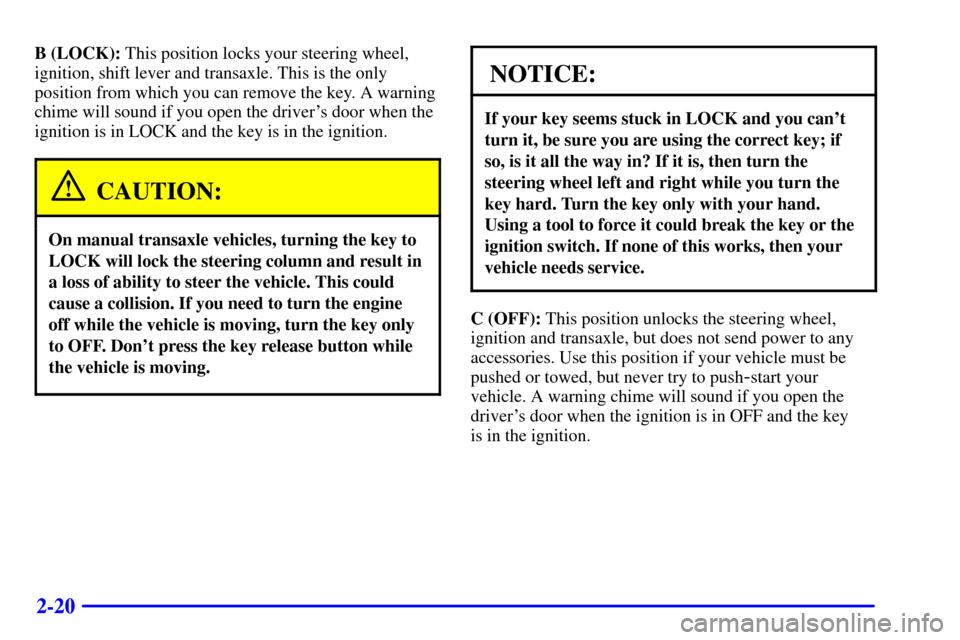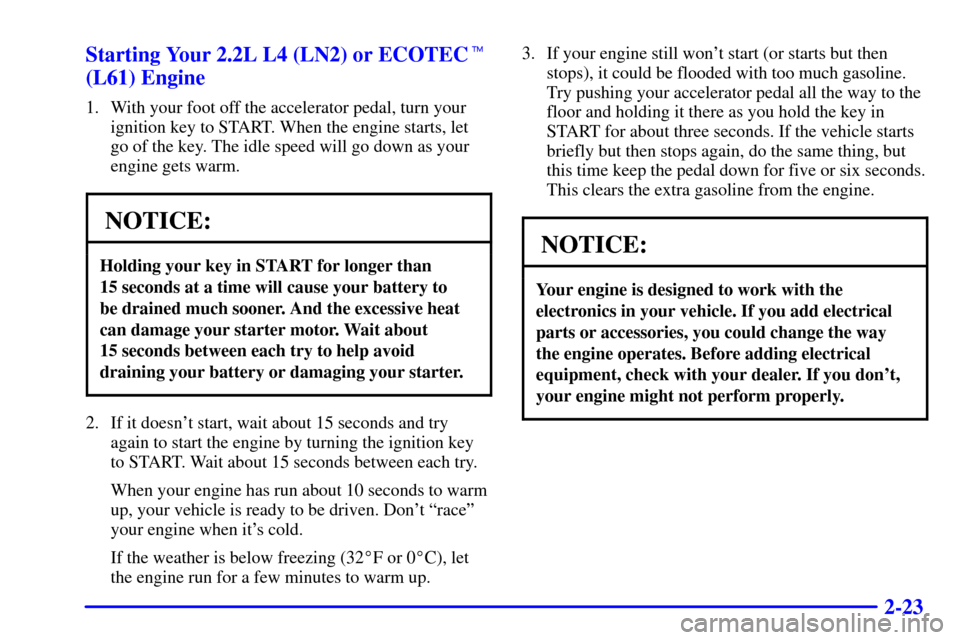Page 77 of 360

2-16
Theft
Vehicle theft is big business, especially in some cities.
Although your vehicle has a number of theft
-deterrent
features, we know that nothing we put on it can make
it impossible to steal. However, there are ways you
can help.
Key in the Ignition
If you leave your vehicle with the keys inside, it's an
easy target for joy riders or professional thieves
-- so
don't do it.
When you park your vehicle and open the driver's door,
you'll hear a chime reminding you to remove your key
from the ignition and take it with you. Always do this.
Your steering wheel will be locked, and so will your
ignition. If you take the key with you, and you have an
automatic transaxle, it will be locked. And remember to
lock the doors.
Parking at Night
Park in a lighted spot, close all windows and lock your
vehicle. Remember to keep your valuables out of sight.
Put them in a storage area, or take them with you.
Parking Lots
Even if you park in a lot where someone will be
watching your vehicle, it's still best to lock it up and
take your keys. But what if you have to leave your key?
�If possible, park in a busy, well
-lit area.
�Put your valuables in a storage area, like your trunk
or glove box.
�Be sure to close and lock the storage area.
�Close all windows.
�Move the trunk release lockout switch to OFF.
�Lock all the doors except the driver's.
�If your vehicle has a remote keyless entry system,
take the transmitter with you.
Page 78 of 360

2-17
Content Theft Security System
(If Equipped)
Arming the System
With the ignition off, pressing the transmitter LOCK
button will arm the system immediately after all doors
and trunk are closed. If the transmitter LOCK button is
pressed again within five seconds, the horn will chirp to
confirm that the system had been armed.
Once the system is armed, the THEFT SYSTEM light
on your instrument panel will flash and remain flashing.
This confirms the system is armed and monitoring the
doors and trunk. If the light is on solid, the system is
not properly activated due to either a door or the trunk
being ajar.
If you don't want to arm the system, lock the car
with the lock levers on the doors or with the door
lock switch.
Disarming the System
If the system is armed, pressing the UNLOCK button
on the transmitter will disarm the system. The THEFT
SYSTEM light will stop flashing.
If the system is armed, turning the key to START will
also disarm the system.
If the system is armed and the trunk is opened using the
trunk release button on the transmitter, the system will
temporarily disarm itself and rearm when the trunk has
been closed. This allows the customer to exit the
vehicle, lock the doors using the transmitter, and open
the trunk using the transmitter without having to disarm
and subsequently rearm the system.
How the System Alarm is Activated
If the system is armed, opening any door or trunk,
or using a wrong key to start the vehicle will cause a
pre
-alarm chirp for 10 seconds and then a full alarm
of horn and headlights for two minutes.
If an alarm event has finished and all doors and
trunk are closed, the content theft security system
will re
-arm itself.
Page 79 of 360

2-18 How to Turn Off the System Alarm
If the system alarm is active, it can be deactivated by:
�Pressing the transmitter LOCK or panic button to
turn
-off alarm. The system will also rearm if all
doors and trunk are later closed, or
�pressing the transmitter UNLOCK or trunk button to
turn off the alarm and disarm system, or
�putting the key in the ignition and turning it to
START to turn off the alarm and disarm the system.
How to Detect a Tamper Condition
If you hear three horn chirps when you press the
UNLOCK, LOCK or trunk buttons on your transmitter,
that means the content theft security system alarm was
triggered while you were away.
Your dealer can change the settings to disable the
headlamp flash and horn chirp features. Your dealer can
also change the settings to allow the horn to chirp twice
on the first press of the UNLOCK button. See your
dealer for more information.
Passlock�
Your vehicle is equipped with the Passlock
theft
-deterrent system.
Passlock is a passive theft
-deterrent system. Passlock
enables fuel if the ignition lock cylinder is turned with a
valid key. If a correct key is not used or the ignition lock
cylinder is tampered with, fuel is disabled.
During normal operation, the THEFT SYSTEM light
will go off approximately five seconds after the key
is turned to the RUN ignition position following an
engine start.
If the engine stalls and the THEFT SYSTEM light
flashes, wait until the light stops flashing before trying
to restart the engine. Remember to release the key from
START as soon as the engine starts.
If the engine is running and the THEFT SYSTEM light
comes on, you will be able to restart the engine if you
turn the engine off. However, your Passlock system is
not working properly and must be serviced by your
dealer. Your vehicle is not protected by Passlock at this
time. You may also want to check the fuses (See ªFuses
and Circuit Breakersº in the Index). See your dealer for
service. Also, see ªRoadside Assistanceº in the Index
for more information.
Page 80 of 360
2-19
New Vehicle ªBreak-Inº
NOTICE:
Your vehicle doesn't need an elaborate
ªbreak
-in.º But it will perform better in the long
run if you follow these guidelines:
�Don't drive at any one speed -- fast or
slow
-- for the first 500 miles (805 km).
Don't make full
-throttle starts.
�Avoid making hard stops for the first
200 miles (322 km) or so. During this time
your new brake linings aren't yet broken
in. Hard stops with new linings can mean
premature wear and earlier replacement.
Follow this breaking
-in guideline every
time you get new brake linings.
�Don't tow a trailer during break
-in.
See ªTowing a Trailerº in the Index for
more information.
Ignition Positions
With the key in the ignition, you can turn the key to
five different positions.
A (ACCESSORY): This position operates your
electrical accessories. Press in the ignition switch as you
turn it toward you.
Page 81 of 360

2-20
B (LOCK): This position locks your steering wheel,
ignition, shift lever and transaxle. This is the only
position from which you can remove the key. A warning
chime will sound if you open the driver's door when the
ignition is in LOCK and the key is in the ignition.
CAUTION:
On manual transaxle vehicles, turning the key to
LOCK will lock the steering column and result in
a loss of ability to steer the vehicle. This could
cause a collision. If you need to turn the engine
off while the vehicle is moving, turn the key only
to OFF. Don't press the key release button while
the vehicle is moving.
NOTICE:
If your key seems stuck in LOCK and you can't
turn it, be sure you are using the correct key; if
so, is it all the way in? If it is, then turn the
steering wheel left and right while you turn the
key hard. Turn the key only with your hand.
Using a tool to force it could break the key or the
ignition switch. If none of this works, then your
vehicle needs service.
C (OFF): This position unlocks the steering wheel,
ignition and transaxle, but does not send power to any
accessories. Use this position if your vehicle must be
pushed or towed, but never try to push
-start your
vehicle. A warning chime will sound if you open the
driver's door when the ignition is in OFF and the key
is in the ignition.
Page 82 of 360
2-21
D (RUN): This is the position to which the switch
returns, after you start your engine and release the
switch. The switch stays in RUN when the engine is
running. But even when the engine is not running, you
can use RUN to operate your electrical accessories, and
to display some instrument panel warning lights.
E (START): This position starts the engine. When the
engine starts, release the key. The ignition switch will
return to RUN for normal driving.
Even if the engine is not running, the positions
ACCESSORY and RUN allow you to operate electrical
accessories, such as the radio.Key Release Button (Manual Transaxle)
The ignition key cannot be
removed from the ignition
unless the key release
button is used.
To remove the key, turn the key to OFF. Then, while
pressing the key release button in, turn the key to LOCK
and pull it straight out.
Page 83 of 360

2-22 Retained Accessory Power (RAP)
Your vehicle is equipped with a Retained Accessory
Power (RAP) feature which will allow the radio to
continue to work up to 10 minutes after the ignition is
turned to OFF.
Your radio will work when the ignition key is in RUN or
ACCESSORY. Once the key is turned from RUN to
OFF, the radio will continue to work for up to 10
minutes or until the driver's door is opened.
Starting Your Engine
Automatic Transaxle
Move your shift lever to PARK (P) or NEUTRAL (N).
Your engine won't start in any other position
-- that's a
safety feature. To restart when you're already moving,
use NEUTRAL (N) only.
NOTICE:
Don't try to shift to PARK (P) if your vehicle is
moving. If you do, you could damage the
transaxle. Shift to PARK (P) only when your
vehicle is stopped.
Manual Transaxle
The gear selector should be in neutral and the parking
brake engaged. Hold the clutch pedal to the floor and
start the engine. Your vehicle won't start if the clutch
pedal is not all the way down
-- that's a safety feature.
Page 84 of 360

2-23 Starting Your 2.2L L4 (LN2) or ECOTEC�
(L61) Engine
1. With your foot off the accelerator pedal, turn your
ignition key to START. When the engine starts, let
go of the key. The idle speed will go down as your
engine gets warm.
NOTICE:
Holding your key in START for longer than
15 seconds at a time will cause your battery to
be drained much sooner. And the excessive heat
can damage your starter motor. Wait about
15 seconds between each try to help avoid
draining your battery or damaging your starter.
2. If it doesn't start, wait about 15 seconds and try
again to start the engine by turning the ignition key
to START. Wait about 15 seconds between each try.
When your engine has run about 10 seconds to warm
up, your vehicle is ready to be driven. Don't ªraceº
your engine when it's cold.
If the weather is below freezing (32�F or 0�C), let
the engine run for a few minutes to warm up.3. If your engine still won't start (or starts but then
stops), it could be flooded with too much gasoline.
Try pushing your accelerator pedal all the way to the
floor and holding it there as you hold the key in
START for about three seconds. If the vehicle starts
briefly but then stops again, do the same thing, but
this time keep the pedal down for five or six seconds.
This clears the extra gasoline from the engine.
NOTICE:
Your engine is designed to work with the
electronics in your vehicle. If you add electrical
parts or accessories, you could change the way
the engine operates. Before adding electrical
equipment, check with your dealer. If you don't,
your engine might not perform properly.